Pumps are the second most used industrial equipment, after engines. Currently, millions of pumps operate around the world, transporting thousands of different types of liquids.
Selecting the right pump from the countless options available is a complex task. To a large extent, pump selection involves matching the capabilities of a specific pump to the system requirements and characteristics of the fluid being pumped.
In this article, we will start with the properties of the pumped liquid, from the perspective of user needs, and then delve into the specifics of pump selection.
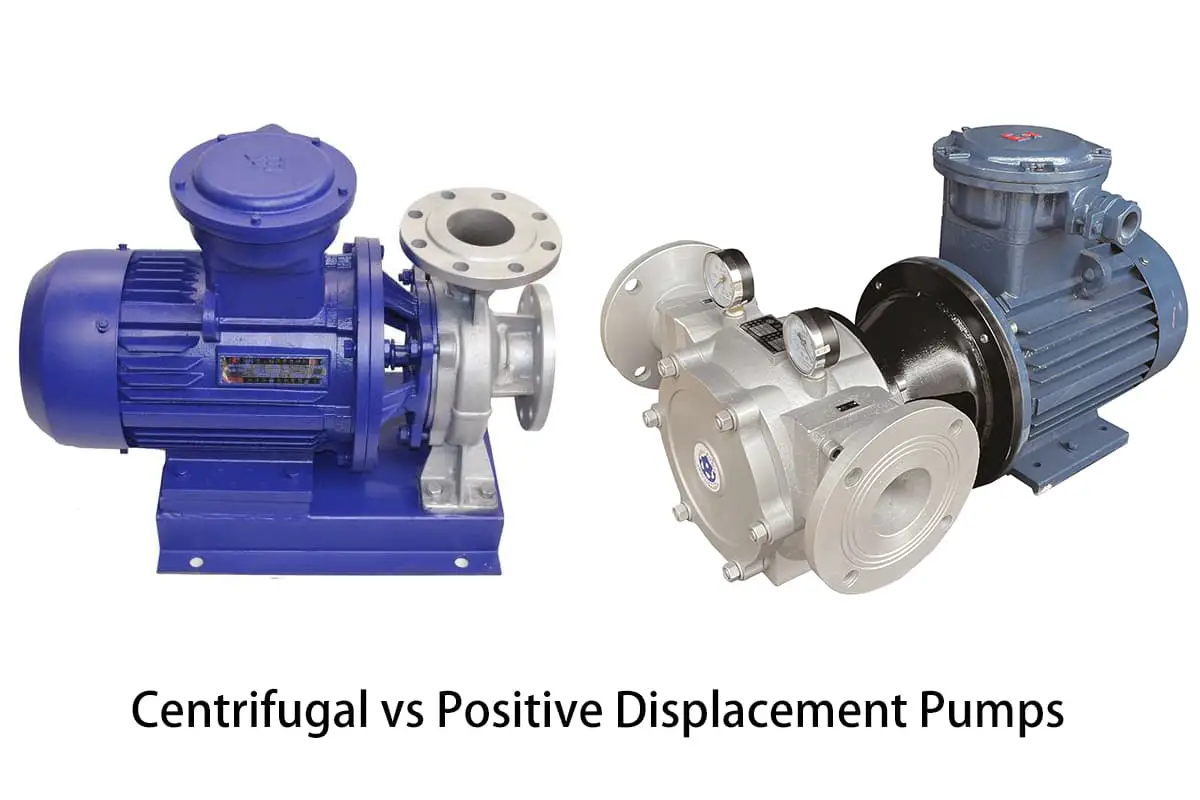
1. Basic requirements
In any application, the first step is to understand the basic requirements that the user has for the pump. For example: inlet conditions, required flow, pressure differential, temperature and fluid characteristics such as viscosity, abrasiveness, shear sensitivity and corrosivity. All of these conditions must be determined before a pump can be selected.
Pumps need to operate under correct suction conditions to function well. In fact, the biggest problem pumps encounter can be attributed to poor suction conditions. Because the pump's ability to push liquid far exceeds its ability to draw liquid, inlet conditions must be maintained within the pump's capacity.
Pressure differential is also a critical factor, especially when considering energy conservation and pump life. Using pipes with smaller diameters and longer lengths can reduce initial system costs, but can also result in a higher pressure differential for the pump.
This higher pressure differential can translate into energy consumption and potentially reduce pump life, which means higher operating costs and lower efficiency.
The required characteristics of the fluid are generally known, and the key is to understand how a given pump affects these characteristics. Most users prefer the liquid discharged from the pump to be in the same condition as when it entered the pump. For proper pump selection, material compatibility, viscosity, shear sensitivity and the presence of specific substances or solids are of utmost importance.
2. Centrifugal Pumps vs Positive Displacement Pumps
Once the basic requirements have been met and the characteristics of the liquid are known, pump selection can begin. Pumps are generally divided into two basic categories: kinetic pumps (the largest types of which are centrifugal pumps) and positive displacement (PD) pumps.
According to data from the US Department of Commerce, about 70% of all pump sales are kinetic pumps, while the remaining 30% are positive displacement pumps. The first step in choosing a pump is to determine which of the centrifugal pumps or positive displacement pumps is best suited to your needs.
Since most industrial pumps are centrifugal, many people will consider centrifugal pumps first. The cost of centrifugal pumps is generally lower than positive displacement pumps and they are also the correct type of pump to use in many situations.
Each type of pump agitates fluid in a unique way and each has its own characteristics and operating curves. It is important to note that centrifugal pumps affect the flow of the liquid, resulting in a certain pressure at the discharge port.
In contrast, a positive displacement pump agitates the liquid by first obtaining a specific amount of liquid and delivering it from the suction port to the discharge port.
For centrifugal pumps, pressure is built first, followed by flow generation. For positive displacement pumps, flow is formed first, followed by the appearance of pressure.
Performance
To choose the most suitable type among various types of pumps, it is crucial to understand the differences in the operating characteristics of these two types of pumps. By looking at their performance graphs (Figure 1a), you can see how different their operating principles are.
Centrifugal pumps exhibit a variable flow phenomenon that depends on pressure (or head), while positive displacement pumps exhibit a more or less constant flow phenomenon that is independent of pressure.
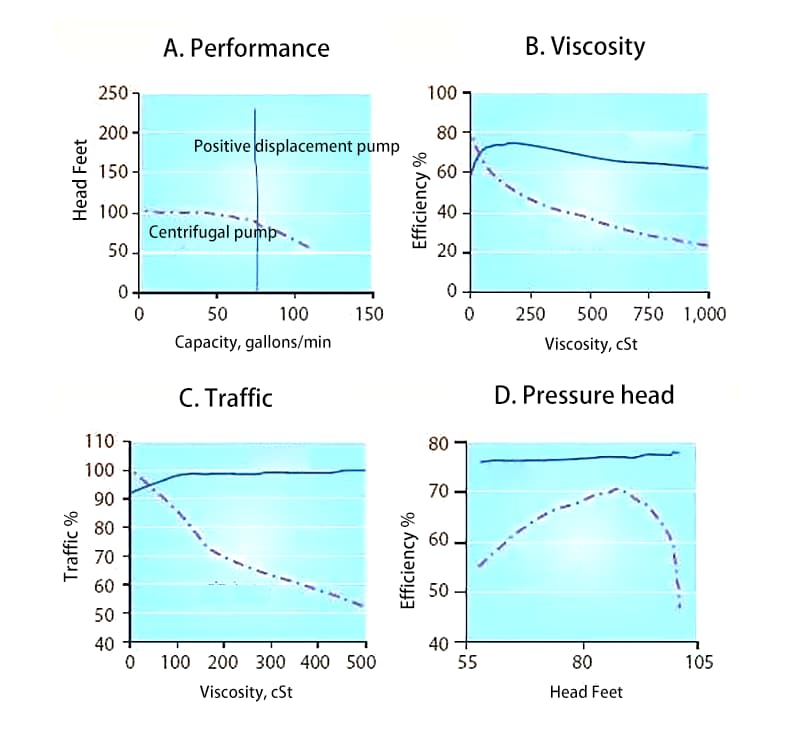
Viscosity
Viscosity plays a significant role in the mechanical efficiency of a pump. Because centrifugal pumps operate at engine speeds, their efficiency decreases with increasing viscosity caused by greater friction losses within the pump. Note that the rate of decrease in efficiency in centrifugal pumps is rapid with increasing viscosity (Figure 1b).
Another important distinction is the effect of viscosity on pump capacity. On the flow chart (Figure 1c), you will notice a decrease in flow as viscosity increases in centrifugal pumps, while positive displacement pumps experience an increase in flow.
This is due to the higher viscosity liquid that fills the voids within the positive displacement pump, resulting in greater volumetric efficiency. Figure 1c only represents the impact of viscosity on pump flow.
Keep in mind that there will also be an increase in pipeline losses within the system. This means that the flow within the centrifugal pump will decrease further as the pump differential pressure increases.
Efficiency
When considering the effect of differential pressure on the mechanical efficiency of the pump, kinetic and positive displacement pumps have different characteristics. Figure 1d illustrates how pump efficiency is affected by increasing pressure.
For positive displacement pumps, efficiency actually improves with increasing pressure, while centrifugal pumps have a Best Efficiency Point (BEP). On either side of this point, the overall pump efficiency drops significantly.
Entry conditions
These two types of pumps have significantly different requirements for inlet conditions. Centrifugal pumps need a certain amount of liquid in the pump to create a pressure differential. A dry pump without liquid cannot start on its own.
Once started, centrifugal pumps must meet specific inlet pressure requirements recommended by the manufacturer.
As positive displacement pumps agitate the liquid by expanding and contracting its volume, negative pressure is created at the inlet, allowing the pump to self-prime.
In some cases, this is the only determining factor when choosing between a positive displacement pump or a centrifugal pump.
Conclusion
In summary, when viscosity exceeds 150 cP, and flow rates over a wide range are required, or when self-priming is desired, a positive displacement pump may be considered. Energy consumption must also be taken into consideration when choosing between centrifugal and positive displacement pumps, as there can be significant differences in energy use between the two.
This is especially important for flow rates below 100 gallons per minute, where the decrease in efficiency is most pronounced for centrifugal pumps.
3. Volumetric Pump
Even after you decide to use a volumetric pump, there are still many options to consider. Before we detail the specifics of each pumping operation, let's first review some common operating characteristics of displacement pumps.
As mentioned above, a rotary volumetric pump discharges the same volume of fluid with each rotation of the shaft. This means that the flow rate of the discharged fluid is proportional to the rotation speed.
In other words, the flow rate can be simply controlled by changing the pump speed. For more viscous fluids, the pump can be dosed just by measuring the number of shaft rotations.
The structure of a displacement pump requires well-fitting internal components and a certain operating clearance. Because of this gap, some fluid will flow back from the discharge end to the suction end.
This phenomenon is known as “slippage”. The amount of fluid that slides depends on the viscosity of the fluid, the pressure difference and the internal clearance of the pump. Lower viscosity generally results in more slip, while thicker fluids will slip less.
Since a volumetric pump always tries to discharge the same amount of fluid, it is important to have the necessary overpressure protection devices in the system. When a blockage occurs in the pump discharge, it generally results in an increase in pressure, which only stops when: the load exceeds the engine limit; some system components break and release pressure; or the pump fails. All of these situations are unsafe. A volumetric pump needs a way to relieve pressure.
To get pressure relief, there are several methods you can choose from. The use of a pressure limiting valve is the most common, but a rupture disc can also be used in the discharge line.
As the drive torque is directly related to the differential pressure within the displacement pump, a coupling with torque limit can also be used. The key is to remember that very high pressures can build up inside the volumetric pump and this must be limited in the case of discharge blockage or partial blockage.
Volumetric pumps can be divided into several types. The American Hydraulics Institute, an organization of pump manufacturers, has published several publications on pump types and standards. They categorize rotary volumetric pumps as: impeller, piston, cam, gear, ring piston, and screw.
Furthermore, there are subcategories for each type of pump, that is, there are several types of volumetric pumps. All of these pumps have the same function of transporting fluid, so how do we choose the right pump?
Although most displacement pumps can be modified to suit a wide range of applications, some types are better than others for a given environment. Fortunately, for basic fluid transport, some pumps have proven to be superior. In the following sections, we will discuss the performance characteristics of internal gear pumps, external gear pumps and impeller pumps.
4. Internal gear pump
The internal gear pump is comprised of an external gear component known as the rotor, which is responsible for driving the internal gear, also known as the idler wheel (Figure 2). The idler pulley is slightly smaller than the rotor and rotates around a stationary pin while operating inside the rotor.
When these components are disengaged, a certain space is formed, allowing liquid to flow into the pump. As these components engage, the volume of the space gradually decreases, forcing liquid to flow out of the discharge port.
Liquid can flow into the expanding cavity through the rotor gears and the recess under the pump head. The last key element of this type of pump design is the crescent-shaped barrier, which is integrated into the pump head.
The crescent-shaped barrier seals the volume of liquid between the idler wheel and the gear, serving as a seal between the intake and discharge ports.
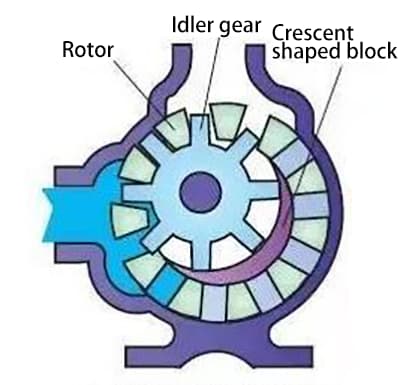
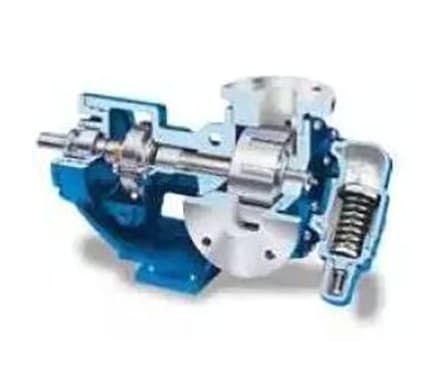
The rotor gear is secured to a gear shaft and supported by a shaft collar or anti-friction bearing (Figure 3). The idler gear assembly also includes a collar bearing that is located within the pumped liquid and rotates around a fixed pin.
Depending on the arrangement of the shaft seal, the rotor shaft support bearing can operate within the pumped liquid. This aspect needs to be emphasized when transporting corrosive liquids, as they can corrode the support bearing.
The actual pressure limit of such pumps depends on the operation of the rotor shaft support bearing. The differential pressure rating of the vast majority of internal gear pumps is 200 psi, although they can be used for higher pressures under the correct application conditions.
The speed of internal gear pumps is relatively slower compared to centrifugal pumps. Generally, the maximum is 1150 rpm, but some small design schemes can reach 3450 rpm. Because internal gear pumps can operate at low speeds, they are suitable for transporting high viscosity fluids, although they can also be successfully applied to thin liquids. Internal gear pumps have successfully pumped liquids with viscosities above 1,000,000 cSt and very low viscosity liquids such as liquid propane and ammonia.
The flow range of this type of pump varies from 0.5 gallons/minute to 1,500 gallons/minute. Materials include cast iron and a variety of different corrosion resistant alloys, including Hastelloy.
Internal gear pumps adopt tight tolerance design during manufacturing, which may be damaged when pumping larger solids. This type of pump can transport small suspended particles in corrosive applications, but will wear out and gradually degrade performance.
In corrosive applications, by choosing corrosion-resistant materials, pump life can be greatly extended. In this case, tungsten carbide, hardened steel or various coatings can provide excellent results.
Internal gear pumps have a wide range of applications and can even be used effectively for shear-sensitive liquids. Application areas include wastewater, polymers, shear-sensitive paints, asphalt emulsions and certain foods such as mayonnaise.
When using this type of pump, only a very small amount of liquid is subjected to shear forces at any one time. Additionally, when necessary, clearance and speed can be adjusted to minimize the impact of shear forces.
4. External gear pumps
External gear pumps operate similarly to internal gear pumps in the pumping action, which consists of engaging and disengaging two gears to drive fluid flow (Figure 4).
However, external gear pumps use two completely identical gears that mesh and rotate with each other. Each gear is supported by a gear shaft and there is a bearing on both sides of each gear. Typically, all four bearings operate within the pumped liquid.
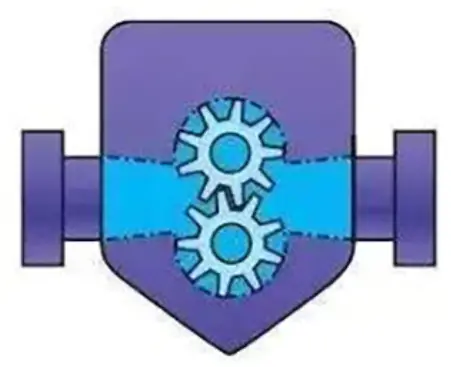
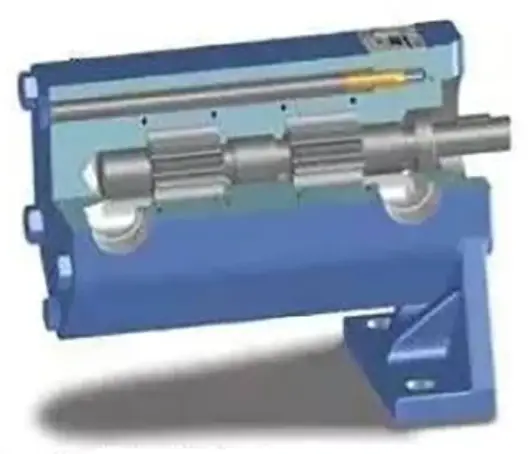
Because the gear is supported on both sides, the external gear pump can be used in high pressure applications such as hydraulic devices.
Pumps designed for hydraulic supply can withstand pressures of thousands of pounds per square inch. Industrial conveyor pumps can handle even higher pressures, but liquid characteristics can limit the pressure range.
Thinner liquids can reach hundreds of psi, while more viscous liquids can approach hydraulic pump pressure. Typically, smaller external gear pumps should operate within a range of 1,750 to 3,450 rpm, while larger external gear pumps operate at a maximum speed of 640 rpm.
The external gear pump's flow range varies from very low (a few drops per minute) to quite high, 1,500 gallons per minute. External gear pumps can be manufactured from a variety of raw materials, including high-quality alloys.
External gear pump designs may use tighter tolerances than internal gear pumps. However, external gear pumps do not tolerate particles in the pumped liquid. Since there is play at both ends of the gear, it is not possible to adjust the end play for wear. After the external gear pump wears out, it must be reassembled or replaced.
As long as the speed is adjusted correctly, especially for liquids with higher viscosity, the external gear pump can handle viscous and watery liquids. Since viscous liquids require some time to fill the spaces between the gear teeth, the pump speed must be significantly reduced when pumping viscous liquids. Its viscosity limit is actually the same as that of an internal gear pump, both at 1,000,000 cSt.
External gear pump performance under critical suction conditions is not ideal, especially for volatile liquids. Volatile liquids often undergo partial evaporation when the space between the teeth expands rapidly.
5. Impeller Pump
The operating principle of the vane pump is theoretically similar to other volumetric pumps with expanding and contracting volumes, but it employs a different mechanism to realize this theory (Figure 6). Interestingly, the booster pump essentially consists of two pumps in one.
The first pumping action is generated by volume expansion between the impeller, impeller and pump casing, while a less noticeable pumping action occurs in the area below the impeller.
In this area, whether the impeller enters or exits the rotor groove, a pumping action is formed, which actually accounts for about 15% of the total pump displacement.
Typically, this area is ventilated through slots inside the impeller or rotor. It is crucial to understand this, especially when dealing with more viscous liquids, as the flow of viscous liquid in and out of the area between the impellers can be more challenging.
Therefore, the maximum recommended average viscosity for this type of pump is approximately 25,000 cSt.
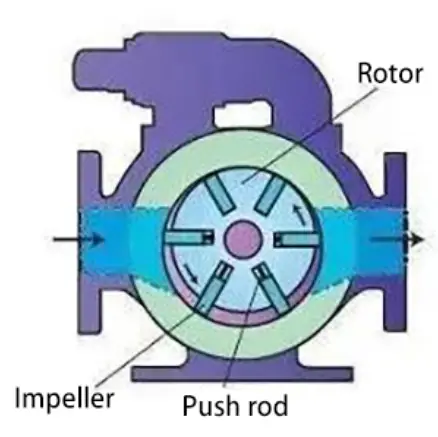
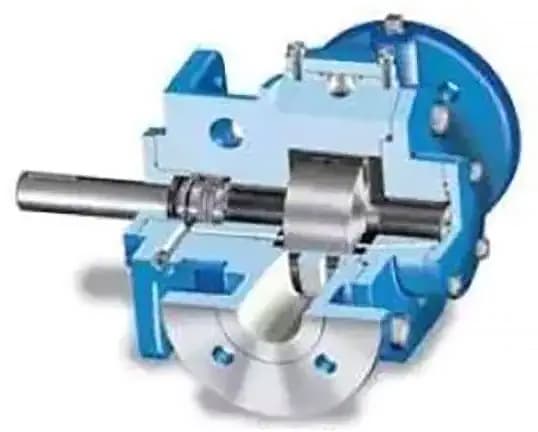
The impeller, which is the main sealing component between the intake and discharge ports, is generally made of non-metallic composite materials. Because there is no metal-to-metal contact, impeller pumps are often used for low-viscosity liquids without lubricating effects, such as propane and ammonia. Because the impeller comes into direct contact with the pump casing and internal clearance is minimized, the sliding characteristics of thin liquids can be optimized.
Most conveyor impeller pumps limit pressure to 125 psi, although some are rated for 200 psi. The pressure limit of the impeller pump largely depends on the resistance of the impeller.
Thanks to the non-metallic impeller and very small operating clearances, impeller pumps can initiate priming operations very well. When the pump begins the priming operation, it must discharge air, and what is discharged is a very thin fluid. Because impeller pumps can do this well, they are sometimes used as vacuum pumps.
Impeller pumps are typically supported on both sides of the impeller by shaft sleeves or anti-friction bearings. If shaft sleeve bearings are used, they will work in liquid. If anti-friction bearings are used, internal pump seals must be used to allow the bearings to operate in lubricating oil or grease. This design requires two mechanical seals, one on each side of the rotor.
Impeller pumps generally operate in the speed range of 1,000 to 1,750 rpm, and flow rates can reach up to 2,000 gallons/minute. However, when dealing with high viscosity liquids, the required velocity will be significantly reduced to allow the liquid to enter under the impeller.
In applications dealing with high viscosity liquids, impellers made from stronger materials are required to prevent breakage. The most common materials for impeller pump construction are cast iron or ductile iron. Some manufacturers use stainless steel materials in pumps that must handle thin, corrosive liquids.
Impeller pumps can handle some corrosive substances, but not solids. For applications pumping corrosive substances, care must be taken to correctly choose the impeller and sealing materials. Like external gear pumps, impeller pumps have fixed end clearances at both ends of the rotor and impeller.
When wear occurs, these gaps cannot be adjusted; however, some manufacturers now offer replaceable or reversible end caps. Using a casing liner is also a way to restore pump performance when wear occurs.
Summary
Understanding the operating principles of various pumps is a good start to properly selecting a model for a given application environment. Although the distinctions between the various options may not be very clear, basic differences in operation and capacity can be used to guide selection.
Internal gear pumps can be used in a wide range of applications, but they generally operate more slowly than other pumps. Initially, choosing an internal gear pump may result in slightly higher costs, but compared to slower-running pumps, its useful life tends to be longer.
External gear pumps have excellent pressure handling capabilities and precise flow control characteristics, but cannot be used to handle solid or corrosive media. The manufacturing cost of external gear pumps is lower, so they are an economical and reasonable choice in lower demand application fields.
Impeller pumps work well when transporting thin liquids, but must operate at reduced speeds when handling viscous liquids. Impeller pumps also cannot support solid materials.
Incorrect pump selection often leads to higher costs. Specifically, it can negatively impact downtime, lost production, maintenance costs and energy consumption. Spending more time choosing the right pump in the right system can minimize unnecessary expenses and achieve greater long-term benefits.

























































